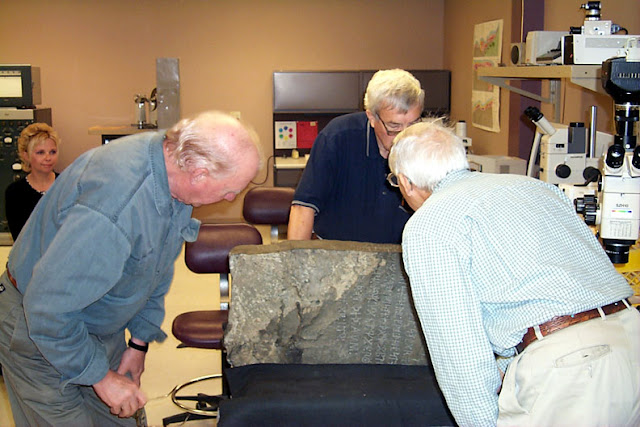Since I had been referred by my former geology professors at the University of Minnesota-Duluth to do this work for the Runestone Museum on Alexandria, Minnesota, it only seemed appropriate to invite them in for a cursory look and to pick their brains for ideas on how to approach the investigation. I already had a number of ideas and wanted to run them by my professors for their input. On July 14, 2000, the six professors invited showed up along with then liaison for the Runestone Museum, Barry Hanson. Professor's Emeritus, Dr. John Green, Dr. Richard Ojakangas, and my former adviser, Dr. Charles L. Matsch drove down together from Duluth and Dr. Ken Harris, Dr. Robert Johnson and Professor Emeritus, Dr. Paul Wieblen from the University of Minnesota in Minneapolis.
The professors spent about 4 hours examining the geological features of the stone and the inscription offering comments and ideas of what might be interesting to look at more closely at during my examination and testing of the artifact. At one point when we turned the stone over to look at the deep glacial striations and scratches on the back side, it was Dr. Paul Wieblen who first noticed the white-colored, branching lineations. He pointed to the marks and said, "These features kind of look like roots." I would eventually conclude they indeed were made by the very same roots of the tree under which Olof Ohman discovered the stone.
The "Geologic Dream Team" was extremely helpful and Dr. Richard Ojakangas, one of the top sedimentary petrologists in the world, offered to perform a mineralogical point count on one of the thin sections we made from the core sample taken from the back side of the artifact. His point counts and my points counts were pretty much the same and we agreed the original slab of stone was a meta-graywacke that originated from the Animikie Basin in east-central Minnesota of Paleoproterozoic Age (1.85 to 2.1 billion years ago).
Upon completing my initial report, Dr's Green, Matsch and Ojakangas provided written peer reviews of my geological findings along with Professor Emeritus G.B. Morey, and geologist, Terry Swor. All found the report to be accurate and thorough. Looking back after these twenty years I want to thank all of these accomplished geologists for sharing their geological expertise and offering suggestions as well as their support. It was Dr. Ojakangas' work and vast experience that led to the conclusion the rock was indigenous to Minnesota and not brought along by the Kensington party from the East Coast or Europe. I remember Dick Ojakangas once told me a colleague said to him, "If you help Scott with the Kensington Rune Stone it could damage your reputation." Dick said he smiled at him and said, "Thanks, but I'll take my chances."
It was the geological weathering aspects of the inscription and split side that told me they were at least 200 years old from the day Olof pulled it from the ground in 1898. This made a late Nineteenth Century hoax impossible and therefore, it had to be an authentic artifact. The hard science speaks just as loud today as it did then. It's time the world accepted this amazing stone for the vitally important historical artifacts that it is.
Geologist, Scott Wolter looks at a computer monitor with a magnified image on the split side of the Kensington Rune Stone in July of 2000.
Dr. Paul Wieblen points to the white lineations on the back side of the Kensington Rune Stone and was the first to say they looked like markings left by roots. L to R, Barry Hanson, Dr. Richard Ojakangas (with camera), Dr. Robert Johnson (behind Wieblen), Dr. John Green and Dr. Charles L. Matsch (bending over in front) look on as Wieblen explains the root leaching.
L to R, Dr. Charles L. Matsch, Dr. Richard Ojakangas, and Dr. John Green examine the split side of the Kensington Rune Stone as then Runestone Museum Director, LuAnn Patton looks on.
L to R, Dr. Charles L. Matsch, Scott Wolter, Dr. John Green, and Barry Hanson look on as Dr. Richard Ojakangas looks a feature on the split side of the Kensington Rune Stone through a petrographic microscope.
Dr. Richard Ojakangas gets up close and personal with a carved character on the face side of the Kensington Rune Stone.





